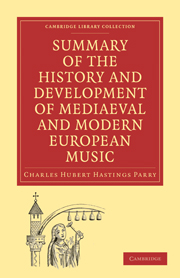Book contents
- Frontmatter
- PREFACE
- Contents
- CHAPTER I THE MUSIC OF THE MIDDLE AGES
- CHAPTER II MUSIC IN ENGLAND FROM THE BEGINNING OF TUDOR TIMES TILL THE RESTORATION OF THE STUARTS
- CHAPTER III THE BEGINNINGS OF OPERA AND ORATORIO
- CHAPTER IV THE PROGRESS OF OPERA IN VARIOUS COUNTRIES, FROM THE MIDDLE OF THE SEVENTEENTH CENTURY TILL THE TIME OF GLUCK
- CHAPTER V ORATORIO IN THE TIME OF BACH AND HANDEL
- CHAPTER VI THE PROGRESS OF INSTRUMENTAL MUSIC UP TO THE TIME OF J. S. BACH
- CHAPTER VII THE PROGRESS OF INSTRUMENTAL MUSIC IN THE EIGHTEENTH CENTURY
- CHAPTER VIII OPERA IN GLUCK AND MOZART'S TIME, AND IMMEDIATELY AFTER
- CHAPTER IX THE PROGRESS OF INSTRUMENTAL MUSIC TO BEETHOVEN AND HIS IMMEDIATE SUCCESSORS
- CHAPTER X MODERN INSTRUMENTAL MUSIC
- CHAPTER XI MODERN OPERA
- CHAPTER XII MODERN VOCAL MUSIC
CHAPTER V - ORATORIO IN THE TIME OF BACH AND HANDEL
Published online by Cambridge University Press: 29 August 2010
- Frontmatter
- PREFACE
- Contents
- CHAPTER I THE MUSIC OF THE MIDDLE AGES
- CHAPTER II MUSIC IN ENGLAND FROM THE BEGINNING OF TUDOR TIMES TILL THE RESTORATION OF THE STUARTS
- CHAPTER III THE BEGINNINGS OF OPERA AND ORATORIO
- CHAPTER IV THE PROGRESS OF OPERA IN VARIOUS COUNTRIES, FROM THE MIDDLE OF THE SEVENTEENTH CENTURY TILL THE TIME OF GLUCK
- CHAPTER V ORATORIO IN THE TIME OF BACH AND HANDEL
- CHAPTER VI THE PROGRESS OF INSTRUMENTAL MUSIC UP TO THE TIME OF J. S. BACH
- CHAPTER VII THE PROGRESS OF INSTRUMENTAL MUSIC IN THE EIGHTEENTH CENTURY
- CHAPTER VIII OPERA IN GLUCK AND MOZART'S TIME, AND IMMEDIATELY AFTER
- CHAPTER IX THE PROGRESS OF INSTRUMENTAL MUSIC TO BEETHOVEN AND HIS IMMEDIATE SUCCESSORS
- CHAPTER X MODERN INSTRUMENTAL MUSIC
- CHAPTER XI MODERN OPERA
- CHAPTER XII MODERN VOCAL MUSIC
Summary
The Italians enjoyed the distinction of giving the start to Oratorio, as they did to most of the other forms of modern musical art; but, after their composers had developed it to the excellent artistic standard of Carissimi and Stradella, a blight seems to have settled on it, and it rapidly became even more mechanical and pointless than contemporary opera. There were many composers who were fully capable of writing effective and fluent choruses, such as Colonna (1640—1695), Lotti (1667—1740), Durante (1684—1755), and Leo (1694—1746), but they reserved their powers in that line for their Psalms, magnificats, hymns, masses, and motets, and submitted to the public preference for solo singing and fluent melody so far as to reduce the choral part of Oratorios to a minimum, and to seek their effect mainly in strings of formal and conventional arias. It remained, therefore, for other countries to develop this great form of art to its highest standard of interest and artistic completeness.
The mood of Germans was eminently favourable. They had more appreciation of choral effect, and regarded the Oratorio form with much more serious feelings than the Italians. Moreover, it happened that the form which they especially cultivated lent itself naturally to very serious and earnest treatment. Italian Oratorio dealt with a variety of subjects; sometimes Old Testament heroes, sometimes allegorical personages, sometimes famous saints. But German religious intensity showed itself by laying hold cf one subject, and concentrating almost all its fruitful energy on the story of the Passion, as told by the four Evangelists.
- Type
- Chapter
- Information
- Publisher: Cambridge University PressPrint publication year: 2009First published in: 1893



